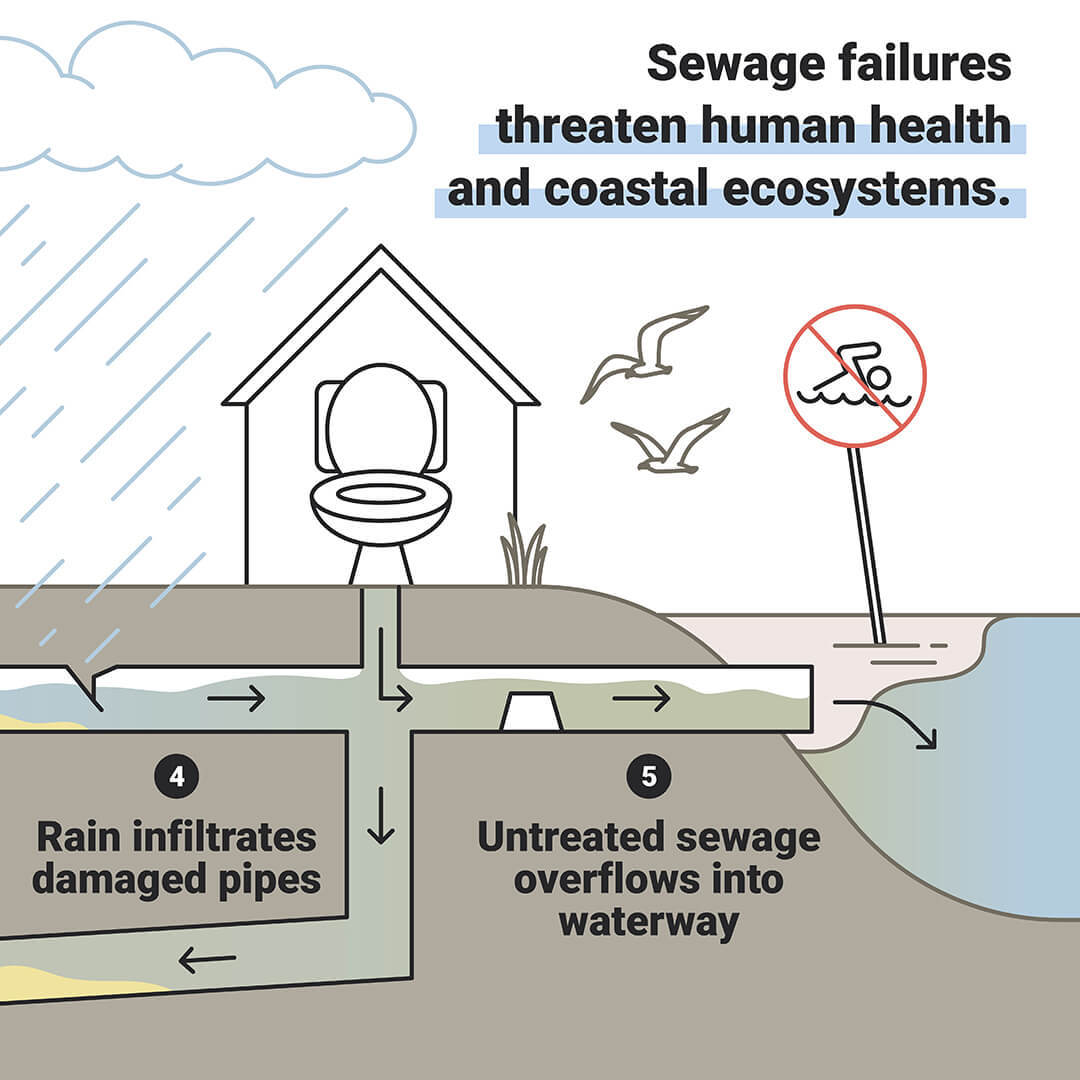
This blog post is the second in a series that explains how the most commonly used wastewater systems fail and pollute our coastal watersheds and the ocean with sewage. View Part 1: Cesspools.
Despite all the benefits that clean water and healthy beaches provide coastal communities across the county, coastal water quality continues to be threatened by discharges of stormwater and sewage. Years, decades even, of neglect, have left America’s wastewater infrastructure in disrepair, outdated and failing. As a result, sewage spills and infrastructure failures release approximately 900 billion gallons of under-treated sewage into surface waters every year.
Sewage can contain bacteria, viruses & parasites that make people sick with gastro-intestinal symptoms, rashes, skin and eye infections, flu-like symptoms, and worse. Sewage discharges also pollute waterways with excess nutrients that wreak havoc on coastal ecosystems by fueling harmful algal blooms that put human health at risk and result in fish kills and coral reef die-offs.
Join us and ask Congress to invest in upgrading America’s failing sewage infrastructure and to protect our coasts and our communities. Send your email here.
How does sewage get to the beach?
Sewage Spills & Failures
As a society, we have long neglected our wastewater infrastructure that lies buried underground. With some cities having sewers that are over 100 years old, we have failed to properly maintain our pipes, pumping stations and other sewage infrastructure. Out of sight and out of mind, until obvious and stinky problems show up, people are often not aware of how their actions in their own houses can affect the proper function of sewers, nor has the proper amount of funding been invested in the needed upkeep of the critical services that our wastewater infrastructure provides for our communities. We have also not expanded the capacity of our sewers to manage the flows generated by growing populations in most communities or upgraded the treatment capacity of our wastewater treatment plants to better treat the effluent before it is discharged into the environment.

What are the problems?
Build-ups of fat and grease in sewer lines cause blockages in the system that can prevent the normal flow of wastewater to the treatment plant and instead result in sewage backing up into the streets, people’s yards and even their houses! Fat and grease should never be poured down the sink but instead thrown away in the garbage.
Likewise, this past year has seen a proliferation of wipes and other personal sanitary products being flushed improperly down the toilets. Cities around the country are reporting their wastewater systems being clogged and otherwise broken down due to wipes, disposable masks and plastic gloves in their sewer systems. Learn more here. All of these items need to be discarded in the garbage and not flushed. Even wipes that are labeled ‘flushable’ are problematic and will cause problems. The fixes are expensive and similar to grease build-ups can result in sewage in people’s bathrooms, yards and the street.
Tree roots growing into sewer lines can cause similar problems with blockages and sewage backing up onto people’s properties. Poorly maintained equipment can also lead to mechanical breakdowns that result in raw sewage spraying into our watersheds and running off into our waterways. Mechanical failures at pump stations are often reported as the cause of sewage spills.

Leaking systems overwhelmed by rain cause overflows
Arguably the biggest problem with poorly maintained sewers is that over the years breaks, cracks and corrosion of pipes, lids and other parts of the wastewater infrastructure allow rain and stormwater to infiltrate in and totally overwhelm the system causing overflows of untreated sewage into local waterways. The separate sewer systems that typically service U. S. cities are designed to be closed systems that receive wastewater only and deliver that wastewater to a treatment plant for proper treatment before it is discharged back into the environment. Broken, cracked and rusty pipes allow rain to seep into the sewer during wet weather. This is particularly problematic during flooded conditions brought on by big storms. Likewise broken manhole covers, uncapped safety overflows, and misconnects between the storm drains and the sewer can let in high volumes of water during rain events. Treatment plants can only handle a certain volume of water at any given time. When this capacity is surpassed, untreated sewage mixed with the stormwater that has seeped into the system, will be released into local waterways to avoid backups in the streets and in people’s homes.
Climate change will make this situation worse as more frequent and more severe coastal storms will occur, dumping high volumes of rain, causing flooding and sewers to overflow. Sea level rise in some coastal cities like Miami is also already causing sunny day flooding and problems within the stormwater and wastewater systems.
Public education is needed so people are more aware of how their actions in their own homes affects the proper function of wastewater treatment locally. More importantly government at all levels needs to better accept their responsibility for repairing and preparing our water infrastructure to meet the needs of society in a changing climate. Better management of stormwater, by encouraging rain to soak into the ground through green infrastructure and low impact development practices is also needed to reduce the impacts of sewage and polluted runoff in coastal communities.
Learn more about Surfrider's efforts to #StopSewagePollution.
